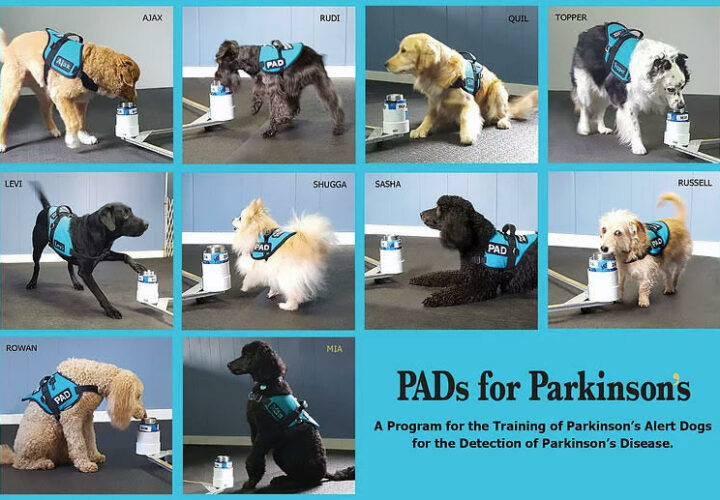Dogs can sniff out the complex metabolic changes that occur in many different diseases, from cancer, to COVID-19, to neurodegenerative diseases. Their superpower of smell is helping scientists uncover better biomarkers for Parkinson’s, and perhaps even Alzheimer’s.
Image courtesy of padsforparkinsons.org
Joy Milne was a nurse who lived much of her life oblivious to her hidden ability. But one day, she noticed something strange. Her husband, Les, had a new and unusual smell. Slowly, along with this musty scent she detected, she began to notice other differences in her husband, too. His personality and mood were changing. Fourteen years later, Les was diagnosed with Parkinson’s.
Milne and her husband got in touch with a Parkinson’s researcher named Tilo Kunath at the University of Edinburgh. While he was originally dismissive of the Milnes, he later learned about dogs that could smell cancer and decided to put Milne’s nose to the test. Kunath recruited two groups of people: those with Parkinson’s and those without. They all wore a t-shirt overnight and then these t-shirts were randomized and presented to Milne.
Milne showed incredible accuracy in detecting the disease, though she did make one mistake. A t-shirt from a control patient was identified as positive for Parkinson’s. Months later, the participant called Kunath to tell him he was diagnosed with the disease.
These research findings sparked more interest from Kunath’s group, as well as the rest of the scientific community, in the metabolic changes which occur during neurodegenerative diseases like Alzheimer’s and Parkinson’s. Further research by Kunath, where Milne is listed as a co-author, even identified the chemical compounds that partially contributed to the Parkinson’s smell.
Importantly, if a human with a super sense of smell can detect these signs, could dogs be trained to do it too?
After reading about Milne’s ability, a group of dog trainers formed a nonprofit dog-training program, Parkinson’s Alert Dogs (PADs). The Chief Science Officer, Jack Bell, a University of Washington analytical chemist, analyzes t-shirts that are sniffed out by the dogs to bolster the search for new biomarkers. Since 2015, the not-for-profit organization has trained 25 dogs to detect Parkinson’s disease with at least 90 percent accuracy.
“My immediate thought was if a human can do it, a dog can probably do it,” said Lisa Holt, a certified “scent work” instructor with PADs. “They are between 10,000 and 100,000 times better at sniffing out odor than we are, and they’re highly selective.”
At PADs, many different dog breeds have been trained to sniff out Parkinson’s. The trainers teach the dogs to alert them after sniffing a training Parkinson’s t-shirt, through positive reinforcement. They do not get the same reward after sniffing training control t-shirts, conditioning them to only alert their handler if a t-shirt is positive for Parkinson’s. Thus, when the trainers present them with a newly donated t-shirt, they make their diagnosis.
“Just about any dog can do it,” Holt said of disease detection through scent, adding that doing what she calls “scent work” is not specific to one dog breed or another, but rather, “more of a temperament thing.” To thrive, she said, dogs need a high intrinsic work ethic.
PADs also collaborates with scientists to help develop an understanding of just how these dogs sniff out Parkinson’s — and how their abilities might inspire new diagnostic tools.
“What we’ve done is taken t-shirts and then shipped them off to some labs,” Holt explained of the shirts worn by Parkinson’s patients. The labs then extract the sebum — oils that are naturally secreted from the skin — from both control and Parkinson’s t-shirts to figure out exactly what the dogs are smelling.
Additionally, some of the shirts are placed in long-term cold storage, so that dogs and trainers can see how these odors may dissipate over time.
It isn’t quite as simple as it may sound: According to Holt, sebum is difficult to extract and handle, and complicating the process further, she says, there is also a lot of “background odor” in the fabric, and that can make isolating and identifying one specific smell challenging.
Now, PADs is focused on testing for another biomarker in the urine.
Their new hypothesis posits that the scent dogs are picking up in the cotton t-shirts may be linked to this biomarker — a byproduct of lipid peroxidation, a form of cell membrane damage, which occurs in the brains of people with neurodegenerative diseases, Holt said.
Like cancer, COVID-19 and the other diseases dogs are being trained to track, Alzheimer’s leads to metabolic changes — some of which dogs could be trained to detect. Understanding their keen sense of smell may be key to developing “electronic noses” and early diagnostics for Alzheimer’s as well as other diseases.



